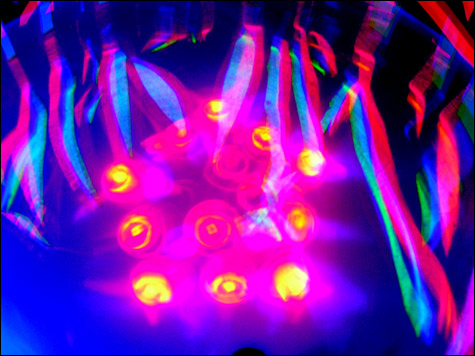
'FRACTAL MOTION' Lyon's immersive funhouse installation. |
Raphael Lyon tells me a story about "Sound and Light," his collaborative installation with Baltimore's Peter Blasser at Stairwell Gallery (504 Broadway, Providence, through May 2). A man came by and asked how much it cost to enter the dark gallery. "He thought it was a ride," like something from a carnival, the Providence artist explains. "To me that was the greatest compliment. I'm interested in experiences. I'm not interested in objects."The experience here is free. Enter past curtains that blackout the space. At the back of the dark room stands what looks like a giant hollow tree trunk, with a glowing, watching dragon eye floating inside. Surrounding the trunk, toward the ceiling, is a constellation of tiny purple lights that look like stars. The space pulses with electronic hums, something like whale calls, beeps, alarm horns, ghost howls. It could be a haunted wood from a fairy tale.

"Sound and Light" is one of a number of immersive, funhouse installations that local artists have been producing over the past decade or so. Recent examples include the striped, mirrored shack that Mike Taylor (who departed for Florida early this year) erected in "New Obstructions" at AS220 last fall, and Jo Dery's tarot-card-reading tent and Jung Hong's mutant ice cream machine at Stairwell last June. Another example is Michael Townsend's installation of caskets and flying figures in a tunnel near the Rhode Island State House. And then there's Brian Chippendale's poster-covered club house, Xander Marro's Dr. Seussy bell tower and, well, practically all the other installations in the RISD Museum's 2006 exhibit "Wunderground," a retrospective survey of artists affiliated with the city's underground poster scene and Providence live-work-art-music-party-lofts like Fort Thunder and Dirt Palace.
The Fort — its walls permanently encrusted with dolls, bicycle parts, masks, and junk as well as its fantastic, temporary Halloween mazes — may be the archetypical manifestation of this local phenomenon. But the interest in spectacle, immediate experience, sensation, and fun could somehow even connect back to the glowing, otherworldly glass installations Dale Chihuly made here in the late 1960s.
Lyon studied art and semiotics at Brown, lived at the Fort, and helped build those Halloween mazes. Like a lot of these artists, the 33-year-old also performs music (under the alias Mudboy), in his case hypnotic droning tricked-out organs plus narrative chanting for an effect somewhere between a pagan rite and a séance. "These environmental works," Lyon says, "they're sort of the visual analog to my music."
Stairwell's second room features what Lyon calls a "kinetic light painting" — projected green and red wiggly lines and, spotlit at the center, a pentagon of red dots fading in and out. It resembles jellyfish tentacles or seaweed. Take the projector apart and you would find lights, lenses, stencils, and micro-controls that Lyon says mainly operate on basic physics — everything carefully balanced so that it jiggles when shaken by visitors moving around the room. The sounds throughout the show are triggered by hidden motion-sensing antennas. Unfortunately, this interactivity isn't apparent — in person, it feels like it all could be preprogrammed.
I felt like I "got" the installation too quickly — cool lights plus strange giant tree plus weird sounds equals psychedelic funhouse light show. It's a neat-o thrill, definitely worth checking out, but it didn't stick with me — at least partly because . . . well, actually I didn't get what Lyon was trying to convey.
What I took to be a tree — a bit abstracted, a bit cartoony, but a tree — Lyon means to evoke something more elemental. His favored motifs are crystals and branching forms drawn from fundamental natural shapes that grow by fractal expansion. Think how veins in trees resemble the courses of great rivers. The sounds in the gallery too follow this "fractal motion, it's similar but it never repeats," Lyon says. "It's kind of random. If you look at the branches on a tree, they look the same but they're not the same. I like to think of it as the shape of life."
I wish the installation did more to point you to this compelling, meaty stuff Lyon is thinking about — how we affect our environment (see: interactivity), sustainable-living (he favors recycled materials), the nature of perception (the optical effects that create the "dragon eye"), and the wondrous mysteries of existence.